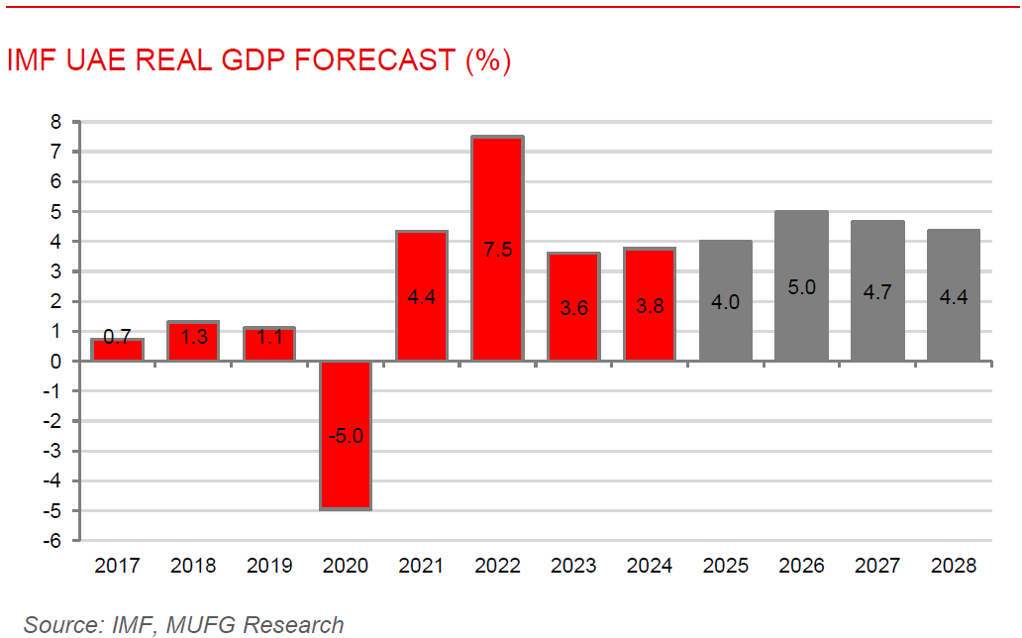To read the full report, please download the PDF above.
Middle East Daily
SOOJIN KIM
Research Analyst
DIFC Branch – Dubai
T: +44(4)387 5031
E: soojin.kim@ae.mufg.jp
MUFG Bank, Ltd. and MUFG Securities plc
A member of MUFG, a global financial group
Middle East Daily
COMMODITIES / ENERGY
Oil rises as EU targets Russian supply and Ukraine strikes intensify. Oil edged higher, with Brent climbing above USD67/b and WTI near USD63/b, as traders weighed fresh European Union sanctions and renewed Ukrainian strikes on Russian energy assets. The EU’s next sanctions package aims at refineries and petrochemical firms in third countries, that facilitate Russia’s oil sales, tightening pressure on Russia’s revenues. At the same time, Ukraine escalated drone attacks over the weekend, hitting refineries and a trunk oil pipeline deep in Russian territory. Despite these geopolitical risks, crude has stayed in a narrow USD5 range since early August, reflecting concerns over a looming market surplus. Easing tensions between US and China after talks between President Trump and Xi further tempered fears of new US tariffs on Chinese oil imports from Russia. Going forward, oil markets are likely to remain rangebound, with sanctions and conflict-related supply risks providing support, while expectations of oversupply and slowing demand growth continue to cap the upside.
Gold extends rally on Fed cut and inflation data focus. Gold logged fifth consecutive weekly gain, trading just below last week’s record high as investors digested the Fed’s first rate cut of the year and looked ahead of key US inflation data for further direction. The Fed’s 25bps reduction initially lifted gold to a fresh peak, though prices later eased after Chair Powell signalled a cautious “meeting-by-meeting” approach to additional moves. Traders are now watching Friday’s personal consumption expenditure price index, expected to show cooling inflation, which could reinforce the case for more cuts. Markets continue to price in nearly two more reductions this year, underpinning gold’s 40% surge in 2025, alongside haven demand tied to geopolitical risks, US tariffs, and strong central bank buying.
MIDDLE EAST - CREDIT TRADING
End of day comment – 19 September 2025. Not much to report about today’s session. Flows were light, seen a bit more of RM selling on the back of the spread tightening yesterday. But the market took bonds easily down coupled with ETF and light local inflows on the demand side. Cash prices broadly closed unchanged in IG which coupled with the UST weakness resulted in another move tighter by around 2bp. In IG once again ADGB 70s outperformed closing +0.125pt/-3bp. QATAR saw a bit of front end selling in 29s but cash prices were glued at yesterday’s levels and just a tad weaker in the long end, 50s closing -0.125pt/-1bp. In higher beta credits OMAN was quoted lower by about 0.125/0.25pt depending on the bond but without any volume behind it, the curve closed unch in spread. QUASI sovereign had some activity in ADNOCM and ADQABU front end were sellers pushed a bit back against the bonds approaching 4% yield levels like ADNOCM 29s, ADQABU 30s, but here as well this selling didn't moved prices much. Fins were quiet today, seen only one print in new EIBUH 31s which is still holding just above its reoffer level of 100.
MIDDLE EAST - MACRO / MARKETS
Syria central bank unveils plan to restore stability and rebuild trust. Syria’s central bank unveiled plans to restore monetary stability by prioritising price control, preserving the currency, and creating conditions for growth, Governor Husrieh announced. Facing challenges such as a large informal economy, sanctions, and liquidity strains tied to Lebanon’s crisis, the bank aims to manage money supply, guide interest rates, and direct credit to productive sectors. Measures include introducing a redenominated currency within three months to simplify transactions and curb unofficial cash flows, boosting banking governance and capital, expanding digital services for financial inclusion, and supporting SMEs. The strategy also relies on managing reserves, stabilising exchange rates, encouraging remittances, and extending concessional loans to priority sectors like agriculture, reconstruction, and energy, with the broader goal of rebuilding trust, controlling inflation, and supporting long-term recovery.
Algeria outlook shows strong recovery but urgent reforms needed. The IMF’s 2025 Article IV Consultation highlights that Algeria’s economy has recovered strongly since the pandemic thanks to high hydrocarbon prices and public spending, but fiscal vulnerabilities have deepened due to falling energy revenues, large deficits, and depleted fiscal buffers. Growth eased to 3.6% in 2024, with nonhydrocarbon activity robust but hydrocarbons contracting, while inflation fell sharply. The near-term outlook is broadly positive with growth projected at 3.4% in 2025, yet risks from volatile oil prices, global uncertainty, climate shocks, and contingent liabilities threaten fiscal and debt sustainability. Without urgent consolidation, estimated at 5% of GDP over 2025-28, public debt could rise above 80% of GDP by 2030, while reserves decline sharply. Key IMF recommendations include phasing out energy subsidies, broadening the tax base, strengthening SOE governance, adopting a rule-based fiscal anchor, allowing greater exchange rate flexibility, and deepening structural reforms to foster private investment and diversification.

